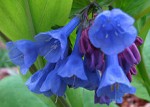 A carpet of Virginia Bluebells in spring is a magnificent sight! These clump forming native plants colonize and naturalize readily providing beauty to a woodland garden for about 3 weeks in spring before the foliage turns yellow and the plant disappears in mid summer. They thrive in the spring sunlight but enjoy cool shade in summer while dormant so are the perfect plant for an area under deciduous trees where the sun can reach them before the trees leaf out. Since the Virginia Bluebells disappear in summer, they should be located near plants that will provide color or other interest in summer and fall.
A carpet of Virginia Bluebells in spring is a magnificent sight! These clump forming native plants colonize and naturalize readily providing beauty to a woodland garden for about 3 weeks in spring before the foliage turns yellow and the plant disappears in mid summer. They thrive in the spring sunlight but enjoy cool shade in summer while dormant so are the perfect plant for an area under deciduous trees where the sun can reach them before the trees leaf out. Since the Virginia Bluebells disappear in summer, they should be located near plants that will provide color or other interest in summer and fall.
Type: Herbaceous perennial.
Bloom: Clusters of purplish-pink buds open to blue 1-1 ½” pendulous flowers in early spring.
Size: 1-2’ H x 12” W.
Light: Spring sunshine and light summer shade such as an area under a deciduous tree.
Soil: Moist, well drained, humus-rich, mildly alkaline.
Hardiness: Zones 3-9.
Pests and Diseases: Susceptible to leaf spot, mildew, rot, slugs and snails.
Propagation: Seed in fall; division in early spring or fall (seed is more reliable) seed or division, but seed is more reliable.
Companion plants: Late blooming daffodils such as ‘Actaea’.
Comments: Once established, plants don’t like to be disturbed.

Hello! I have a question about Virginia bluebells. DO you have to leave the foliage until totally yellowed like you do for daffodils, or can I pull as soon as it starts to droop and the flowers disappear without compromising next year’s flowers?
Thanks!
Nicci,
Leaves are the food factories of plants so the longer they last the better for the plant. The bluebells will disappear by late spring-mid summer so you can place other plants around or in front of them to ill the spot by mid summer.
Karen